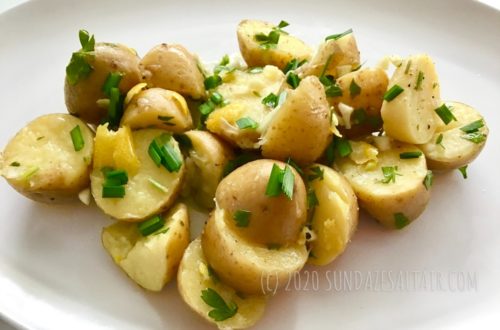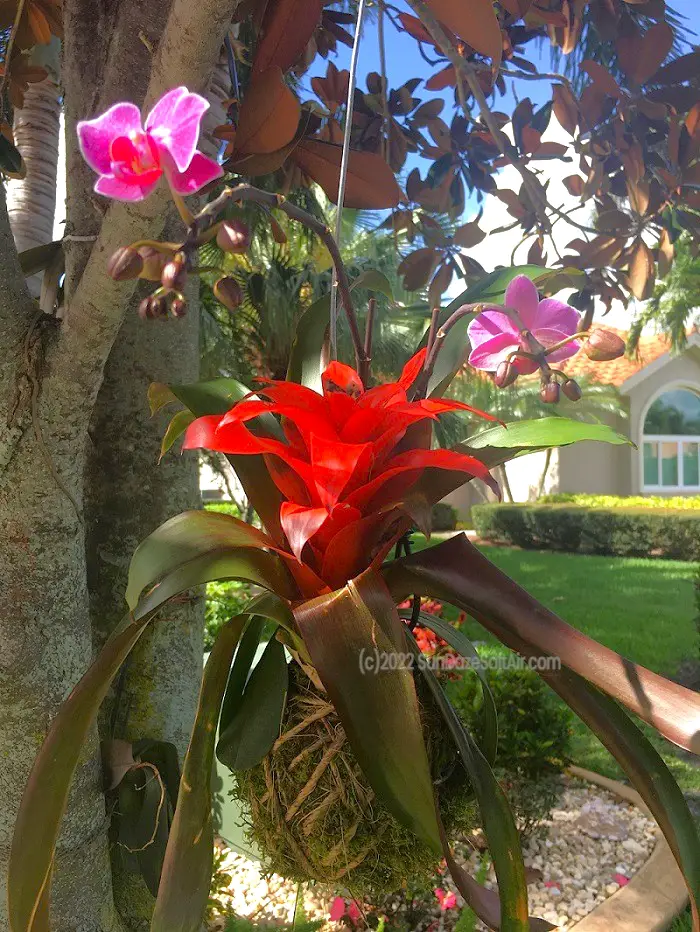
How to Make A Bromeliad Kokedama Hanging Moss Ball for A Beautiful Vertical Garden
Create A Unique Kokedama Air Plant Garden Like A Rainforest
If you have a bromeliad and are looking for a fun, creative way to display your epiphyte plant in the “open air” as nature intended, let me introduce you to Kokedama. In simple terms, Kokedama is the Japanese art of growing plants suspended in a ball of moss. Kokedama lets you turn your air plants, including bromeliads, into eye-level works of art by growing them in what is essentially a hanging vertical garden. Visually captivating yet easy for both the experienced and novice gardener alike, the resulting garden is beautifully tropical yet low-maintenance — provided you have the right plants and conditions. Since Kokedama is not for every plant or environment, let’s discover if you can grow your plants in this amazing and fun rainforest style. Plus, discover how easy it is to make your own bromeliad Kokedama “hanging moss ball” to start a beautiful vertical garden in under an hour…
**Note: This post contains affiliate links for which a small commission may be earned if you decide to make a purchase through a link.
What Is Kokedama?
Kokedama is a Japanese “bonsai” planting style where plants are suspended by string (or wire) while their roots are encased in a moist ball of sphagnum moss. The unique hanging arrangement creates a versatile and striking eye-level hanging garden that manages to be both elegant and rustic at the same time.
If you are considering making your own eye-catching Kokedama, there are a few important considerations…
What Is Kokedama Made From?
A Kokedama moss ball will, of course, always include sphagnum moss for moisture. Sphagnum moss is the best kind of moss to use since it can hold up to sixteen (16) times its weight in water thereby ensuring your plants receive adequate hydration. Depending on the type of plant and growing conditions, some Kokedama gardeners have even been known to add soil to their Kokedama.
For air plants like bromeliads, however, a combination of sphagnum and bright green preserved moss is often all that is used. Combining these two moss types provides the moisture-retaining properties of both sphagnum and preserved moss with the visual appeal of preserved moss.
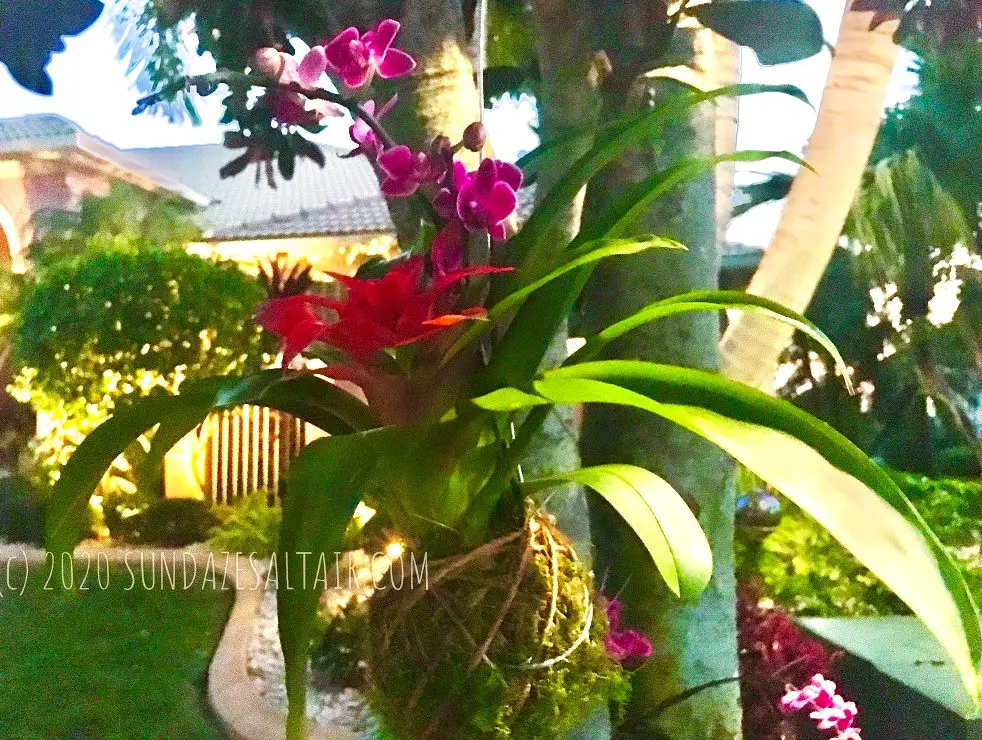
What Plants Grow Best In A Kokedama?
Choose “Air Plants”
Although some fans of the Kokedama method claim that you can grow almost any kind of plant Kokedama-style, the reality is that Kokedama works best on plants that require little to no soil and maximum drainage such as epiphytic or “air” plants like bromeliads or orchids. One such bromeliad that also grows as an air plant is the charming Pink Quill Plant or Tillandsia cyanea. Pink Quill Plant, like other epiphytic bromeliads, needs excellent drainage to grow and is therefore ideal for growing Kokedama-style.
**Display the beauty of your orchids by growing them in hanging baskets here…
**Want to grow your Phalaenopsis on a tree? Click here. Got Vandas? Learn how to grow Vanda orchids on trees here.
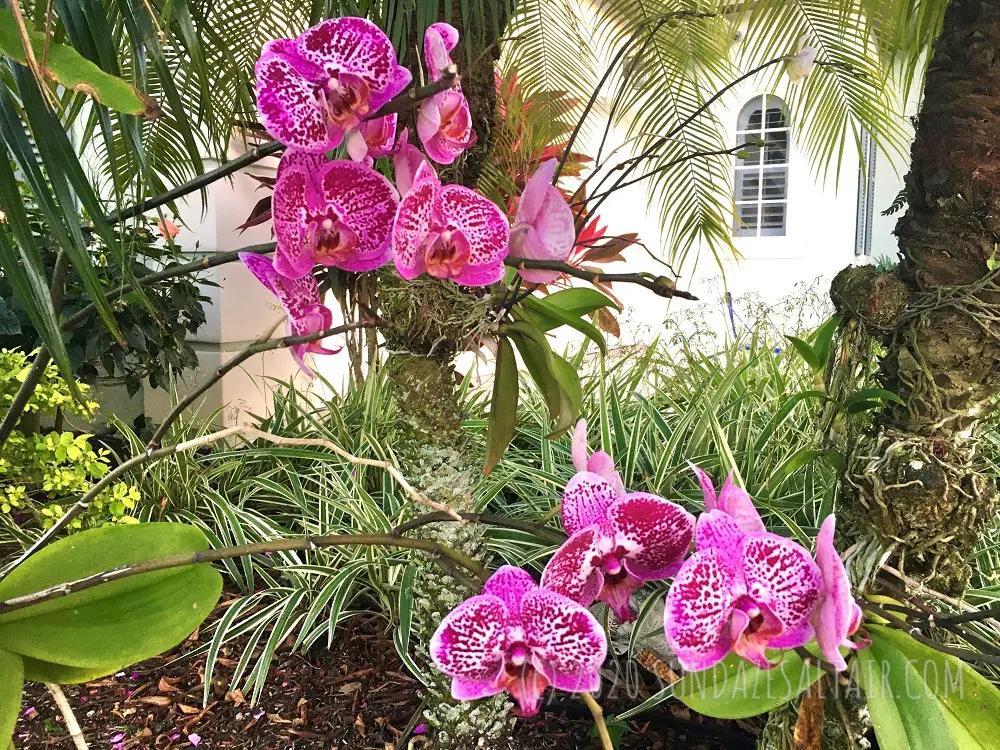
Epiphytes & Kokedama
Growing plants Kokedama-style means growing them with little to no soil making epiphytic “air plants” the best choice to thrive in a Kokedama. Since about 75% of bromeliads are epiphytes, they lend themselves perfectly to this “airy” growing arrangement.
In addition to bromeliads, epiphytic orchids such as Phalaenopsis orchids also adapt well to the Kokedama growing method. As a matter of fact, if you look closely at the bromeliad pictured on this page, you will see that it shares its Kokedama moss ball “home” with a Phalaenopsis orchid.
Plant Size & Kokedama
Of course, when choosing bromeliads for your relatively compact Kokedama, make sure to choose small varieties that grow well in your local climate.
What Type of Climate/Environment Is Best for Growing A Bromeliad Kokedama?
Where Your Bromeliad Kokedama Grows Best
Since many bromeliads are rainforest natives, similar to tropical orchids, for best results, the climate where you grow your Kokedama should also be humid tropical or sub-tropical.
Growing in the tree canopy of the rainforests of South and Central America, the Caribbean and West Africa, epiphytic bromeliads soak up plenty of tropical moisture. So if you are thinking of growing a bromeliad Kokedama in your backyard, keep in mind that humid and tropical growing conditions are what your tropical bromeliads crave.
Another Benefit of Kokedama for Bromeliads? How Bromeliads Absorb Moisture From Their “Cups” & Roots
Collecting rainwater in their central leaf cups is one way bromeliads keep hydrated, while their roots offer another “thirst-quenching” opportunity. Moist sphagnum moss in a Kokedama will help your bromeliad to “drink” its water through its roots.
Can Bromeliads Grow In A Kokedama In A Dry Envrionment?
Not easily. Even with the moisture-retaining abilities of sphagnum moss, it will only be possible to grow a bromeliad kokedama in a dry climate if you hydrate your bromeliad kokedama frequently. Remember, while sphagnum moss is known to hold water, it will quickly become dry during drought. So in a dry climate, it’s on you to regularly check and supply your Kokedama with adequate hydration.
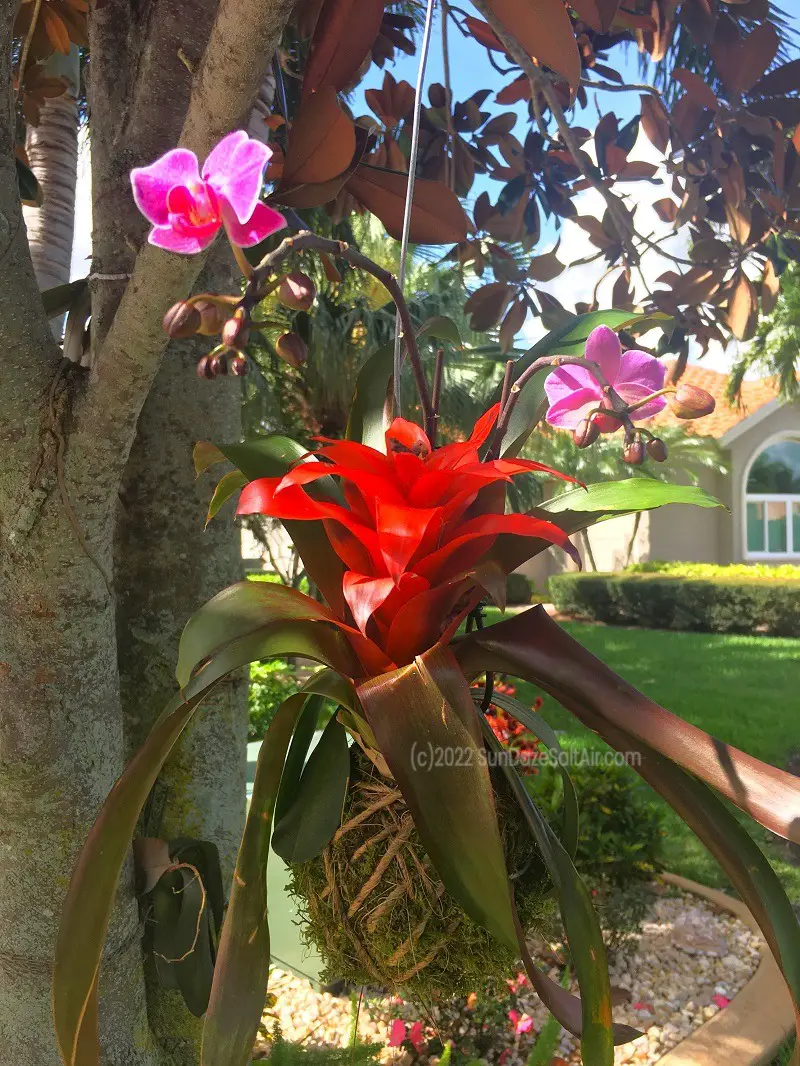
**Did You Know? Epiphytic Bromeliads Provide A Habitat For Frogs In the Rainforest
With bromeliads’ familiar rosette of leaves acting like a cup, tropical bromeliads can both collect and store water as well as provide a home for wildlife. That’s right, bromeliads stay hydrated while their cups serve as water pool “homes” for tree frogs and their tadpoles.
**Don’t be surprised if you see small tree frogs using your bromeliad Kokedama as their home like this little guy is doing with this Dendrobium orchid leaf…
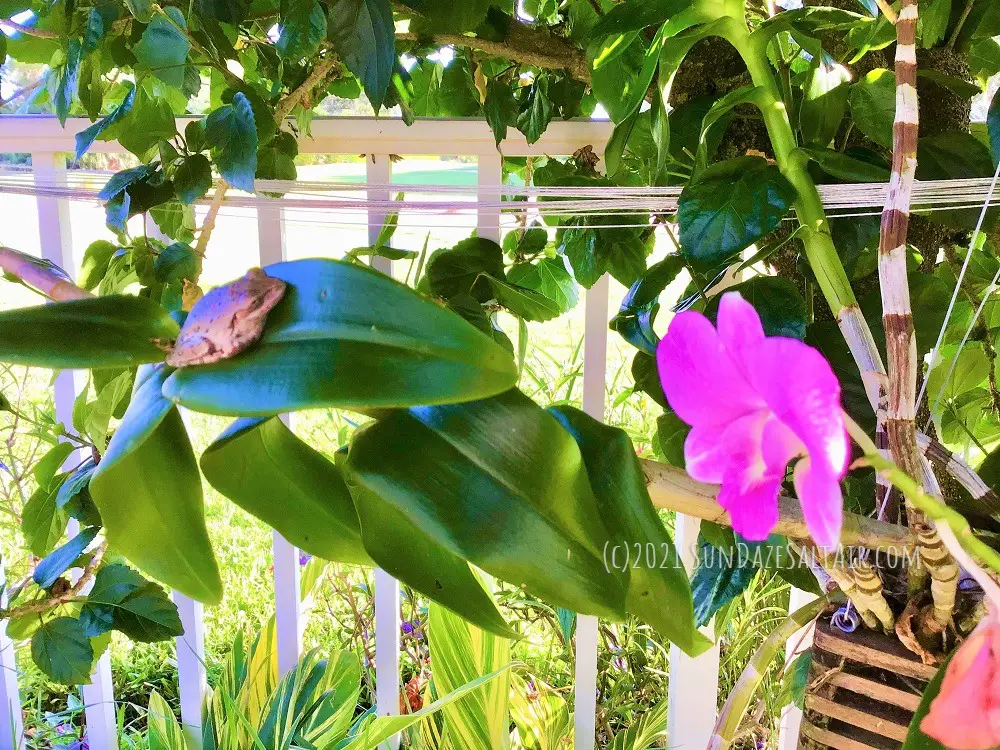
Sunlight & Bromeliads
When hanging your Kokedamas in trees, remember different Bromeliad varieties have different preferences of shade and light. Since there are many bromeliad varieties, always check your plant’s tag for it’s specific sunlight preferences.
Bottomline: Grow Epiphytic Bromeliad Kokedamas In A Humid Environment
If you live in a tropical or subtropical region, you are best-suited to growing your tropical bromeliad as a Kokedama moss ball. In your garden, a Kokedama can be a low-maintenance way for you, and your plants, to experience what it’s like to live in a rainforest…
More Benefits of A Bromeliad Kokedama: Ideal for Small Spaces
A Kokedama Hanging Garden Requires Minimal Space
If you don’t have much of a yard, small hanging Kokedama will give you many of the benefits of a garden even if you have very little garden space to work with.
Kokedama Is Portable
In addition to the increased ventilation and continuous access to moisture in humid surroundings, a bromeliad in a Kokedama can be moved. Your Kokedama can be relocated way more easily that a bromeliad planted in-ground or even one planted in a pot. So, if a storm threatens or if you ever move house, just grab your Kokedama and go…
TIP! How Can You Create A “Kokedama Garden?”
Try hanging a variety of different bromeliads Kokedama-style in a group or cluster for mega-impact in the form of a “Kokedama garden.”
TIP! Expand Your Vertical “Kokedama Garden” With Hanging Orbs Of Flowers Like Disney
**Add gorgeous hanging flower baskets like the ones at Disney World by following the 11 tricks & tips here…
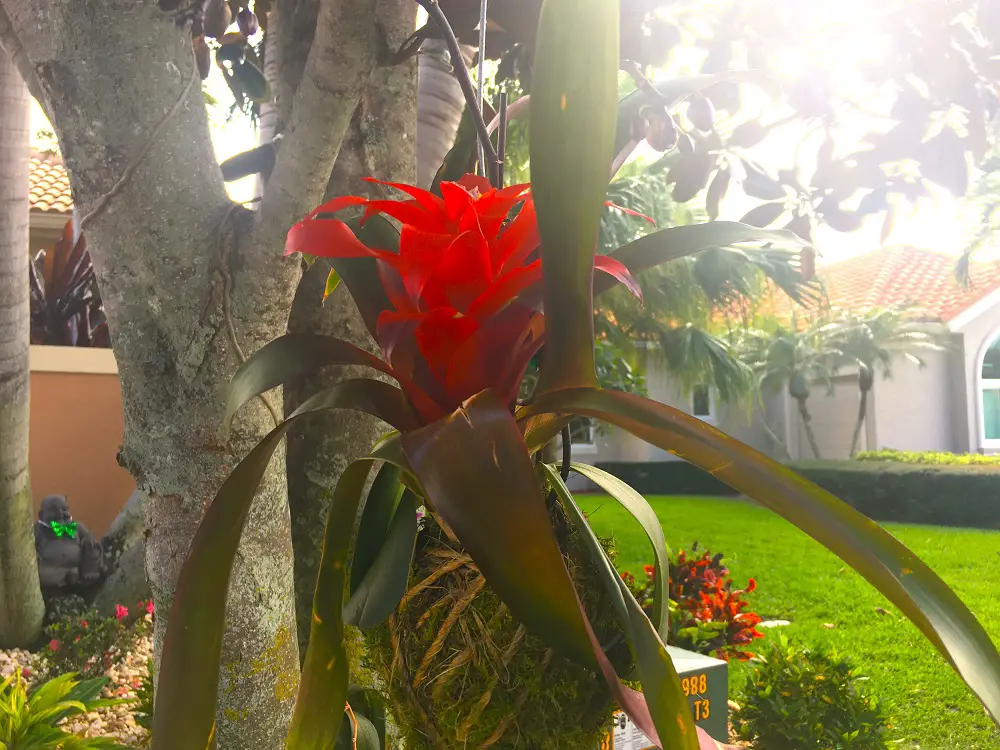
How to Make A Bromeliad Kokedama Hanging Moss Ball for A Beautiful Vertical Garden
Supplies You Will Need:
- Small bromeliad with a healthy root;
- Bag of preserved sheet moss;
- Bag of sphagnum moss;
- Enough water to soak moss;
- Pan or bucket to soak moss;
- Fishing line (to reinforce the Kokedama when the twine disintegrates);
- Garden string (twine);
- Scissors & wire cutters;
- Needle-nose pliers (to bend basket hanger wire);
- Basket hangers (**You may use one to hang each Kokedama ball but there is a more cost-effective method described below…)
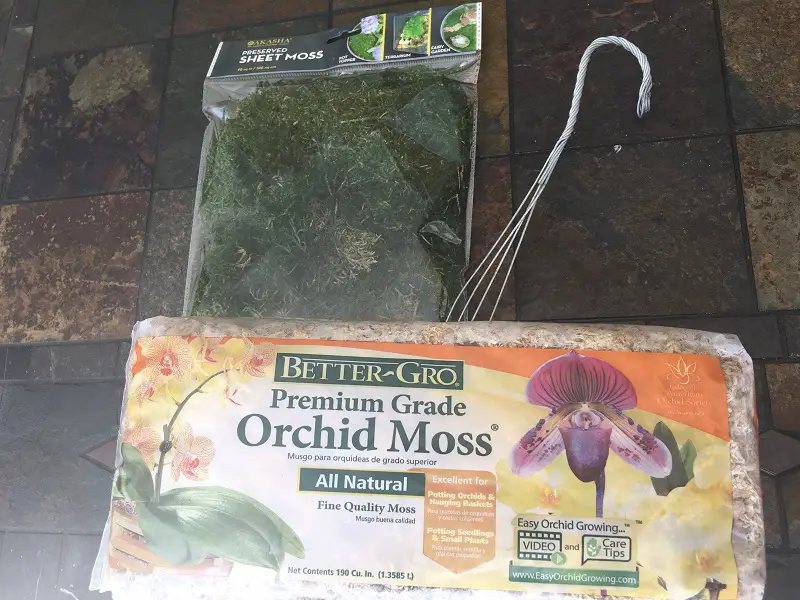

Directions to Assemble A Bromeliad Kokedama Hanging Moss Ball
Preparation:
- While you may use one metal basket hanger per Kokedama ball, there is a less expensive method wherein you can get multiple hangers out of one! Start by taking one metal basket hanger, as pictured above and, using your wire cutters, cut the long wires where they separate (directly beneath the hanging loop.) Proceed to cut the wires at approximately 7-inch intervals. This should result in a number of smaller sections of wire, which you should set aside until you get to the step titled, “Make the Bromeliad Kokedama Hanger.”
- Soak and combine your moss in a bucket or pan of water until it is completely saturated.
Form the Bromeliad Kokadama Moss Ball & Wrap With Fishing Line:
- Grab a handful of wet moss and begin wrapping it around the root ball of your bromeliad, adding more until it is in the shape of a ball.
- Once you have a ball shape at least roughly the size of a baseball covering the roots, take some fishing line and wrap it around the moss ball with one hand as you hold the ball with your other. Adding a layer of fishing line first before wrapping it with string will support the ball even when the cotton string disintegrates.
- Add additional moss if you find the ball compresses a lot as you wrap it. Then simply wrap more fishing line until the moss is securely bound in a ball around the root.
Wrap the Kokedama With Cotton String:
- Without cutting the line, pull out some cotton string and begin wrapping it around the Kokedama ball tightly and evenly over the fishing line.
- Once you are satisfied that the Kokedama is well-supported, pull out enough extra cotton string and line so you are able to hang the ball when it is finished. Use your scissors to cut both string and line.
- Take the ends of both and pull them under and through a tight section close to the base of the plant. Then bring the string and fishing line over to the opposite side and again pull them both under a tight section at the base.
- Finish by tying and knotting the string and line. The end result should resemble long handbag straps, which you will now use to hang your bromeliad Kokedama.
To Make the Bromeliad Kokedama Hanger:
- Take one of the 7-inch pieces of wire that you cut earlier and position two inches of it through the top of the string/line hanging loop you created above. Use the needle-nose pliers to twist the wire end up into a very small loop so the wire hooks onto and securely holds the string/line. Then simply bend the other end of the wire into a half circle to make the “hanger.”
- Now, hang your beautiful Kokedama from a nearby tree branch and prepare to get lots of questions and ooh’s and ah’s from your neighbors…
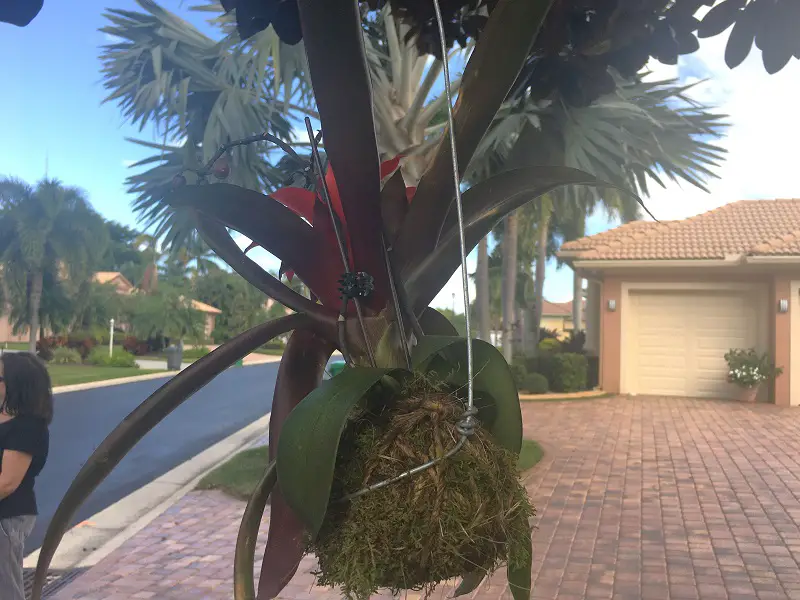
How to Make A Bromeliad Kokedama Hanging Moss Ball for A Beautiful Vertical Garden? Just Bookmark & Share These Tips
Creative and fun, growing bromeliad Kokedama on moss mimics how many grow naturally in rainforests. Just make sure you have the right warm and humid conditions for your bromeliad, and you too can create an enchanting vertical “rainforest” paradise in your own backyard.
Be sure to bookmark and share this page so everyone you know can try Kokedama… After all, in the right climate, Kokedama can be a low-maintenance way for you, and your plants, to experience what it’s like to live in a rainforest…
***Have you ever made a Kokedama? Share your experience in the comments!
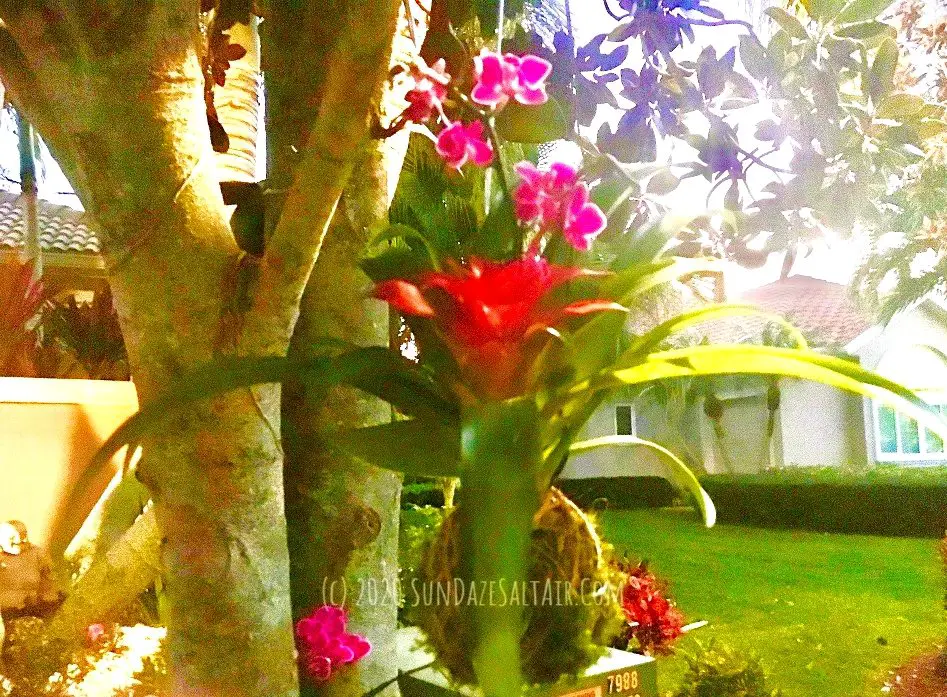


You May Also Like

How To Transfer Photos From iPhone To USB Flash Drive & Free Up Space On Your Phone – No Cloud Necessary
December 6, 2021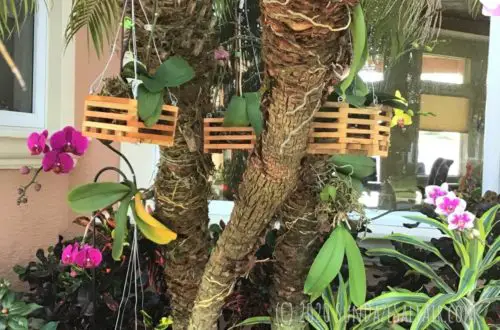
How To Grow Orchids In Wood Baskets (With Pictures)
May 6, 2021